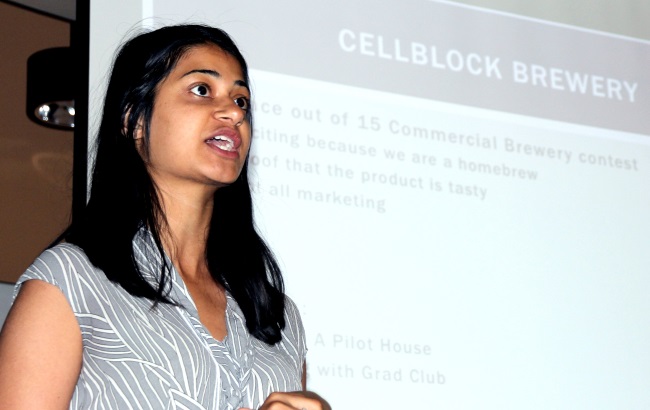Student entrepreneurs get innovative
August 18, 2014
Share

This article is published in the Aug. 12 edition of the Gazette. Pick up your copy of the newspaper at one of the many locations around campus.
By Andrew Carroll, Gazette editor
Friday mornings throughout the summer there is a group of students who gather in Beamish-Munro Hall. Divided into teams, they take their turn at the front of Room 313 and provide a progress report on their projects.
This is a 3-2-1 meeting. They have three slides, two minutes for presentation and one minute for questions.
These are young entrepreneurs and they are taking part in the QueenâÂÂs Summer Innovation Initiative (QSII).
Run by the QueenâÂÂs Innovation Connector (QIC), the program brings together students from a number of faculties, as well as St. Lawrence College, with a range of backgrounds. Their goal, however, is the same â to plan and create a product and then make it market-ready.
From a device providing digital video in boreholes deep in the earth to a microbrewery drawing upon KingstonâÂÂs a prison town heritage to an electronic device cleaner for hospitals, the projects are imaginative and diverse.
QIC itself was established in 2012 as a collaboration between QueenâÂÂs School of Business and the Faculty of Engineering and Applied Science. The aim, along with that of QSII, is to build on the universityâÂÂs strengths âÂÂin cultivating ideas and fueling discoveries.âÂÂ
It is clear within a few presentations at the 3-2-1 meeting that those goals are being met.
 Leading the way at the QSII are Jim McLellan, QICâÂÂs Academic Director, professor and head of Chemical Engineering and Engineering Chemistry, Greg Bavington, QICâÂÂs Executive Director, and Alix Murphy, QSII Co-ordinator. University Communications
Leading the way at the QSII are Jim McLellan, QICâÂÂs Academic Director, professor and head of Chemical Engineering and Engineering Chemistry, Greg Bavington, QICâÂÂs Executive Director, and Alix Murphy, QSII Co-ordinator. University CommunicationsLeading the way at the QSII are the trio of Greg Bavington, QICâÂÂs Executive Director, Jim McLellan, QICâÂÂs Academic Director, professor and head of Chemical Engineering and Engineering Chemistry, and Alix Murphy, QSII Co-ordinator. The 16-week paid internship program, now in its third year, is aimed at advancing innovation and entrepreneurship and each summer has a fresh crop of bright minds, eager to see their ideas come to fruition.
While there are similar programs at other schools, QSII differentiates itself in the breadth of programming and that it is a pan-university effort. Instead of belonging to a particular faculty the QIC reports to the Provost. There is tangible support from all the major faculties and even the Alma Mater Society.
In a short time, the team has seen a lot of progress.
âÂÂIâÂÂd say weâÂÂve leap-frogged most of them,â says Mr. Bavington when comparing QSII to similar programs in Canada. âÂÂWe donâÂÂt have the track record, we donâÂÂt have the scale but IâÂÂd say our programming is exceptional and at the leading edge.âÂÂ
For example, Mr. Bavington and Dr. McLellan recently attended a symposium in Massachusetts where the organizers offered a list of around 20 best practices for on-campus incubation. QSII had already implemented all of them on its own.
One is that the teams are formed by the students themselves, rather than being pre-selected by the directors. The reason for this is simple: while there may be some hurt feelings and awkward moments for the students, it mirrors what really happens in the private sector.
ThatâÂÂs experiential learning and that is key to the program. It is not an academic certificate course and isnâÂÂt run as such. The projects really are start-ups and there are no grades.
The teams do not work in isolation either. While there is plenty of competition, with a $30,000 first prize on the line to help grow the teamâÂÂs business, there also is a massive amount of collaboration. The weekly meetings are an example. Not only are the teams giving a progress report, they are turning to their peers for ideas, support, and perhaps most importantly, constructive criticism. Teams and individuals are held to account.
âÂÂThey enjoy problem solving and they enjoy brainstorming and they enjoy critical thinking and they enjoy creativity,â Dr. McLellan says. âÂÂAnd where you will see that is in these 3-2-1 presentations where each venture will say âÂÂhere is what we have done, here is our timeline and here are some of the obstacles.â They just sort of put it out there and they get feedback. Everyone understands that it is time for a constructive but potentially critical feedback.âÂÂ
Now with the third group of students working on projects, the team is confident in saying that there is a large amount of interest in such a program and that QueenâÂÂs students are showing that they are self-starters and bring a strong mix of initiative, creativity and critical thinking to the table. Yet, they arenâÂÂt perfect, Mr. Bavington says.
âÂÂOne of the things that IâÂÂve learned personally is that I am absolutely convinced not only is there a lot of pent-up demand, thereâÂÂs a lot of talent in these young peopleâ he says. âÂÂTheyâÂÂve got a ton of talent, theyâÂÂre nice kids, theyâÂÂre well-intentioned kids, theyâÂÂre bright, eager, highly motivated, theyâÂÂre organized and theyâÂÂre fun. But one of the weaknesses that they have is that they have failed very rarely in their lives.âÂÂ
Many of the students have been the top of their class throughout their education. The QSII program will challenge them like never before and by the time the program is over there are plenty of students who realize that entrepreneurship is not for them.
However, they will have gained much.
âÂÂSome of the important qualities for entrepreneurship are thinking on your feet, being able to say something succinctly, take an idea, figure out what you donâÂÂt know, what you donâÂÂt know and being able to go dig and figure out what you need to know,â Dr. McLellan says. âÂÂThose are all sorts of critical thought qualities you want in students anyway.âÂÂ